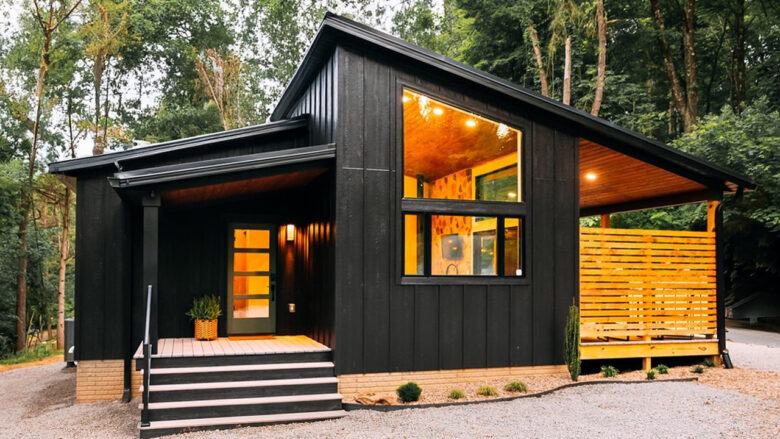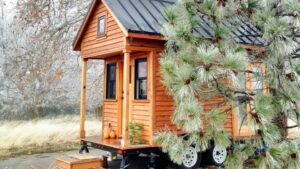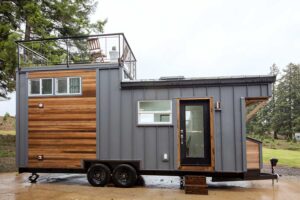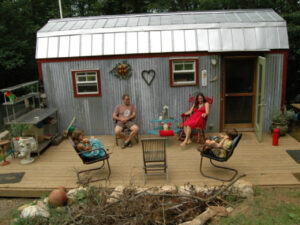In recent years, an exciting new trend has emerged in the real estate market: the rise of luxury tiny homes. People who want a simpler, greener, and more aesthetic lifestyle are interested in these small but stylish houses. This article discusses the idea of luxury tiny homes, their appeal, and what is making them increasingly popular.
1. Defining Luxury Tiny Homes
Most tiny homes are small, with room sizes typically ranging from 100 to 400 square feet. Luxury tiny homes are unique because they focus on high-end design, quality materials, and new features to make the most of space while still being comfortable and practical. These homes are not only smaller but also represent a choice that costs less and favors quality over quantity.
2. Construction and Design
Luxury tiny homes are a great example of creative architecture and design. Architects and designers take up the challenge of creating great spaces without sacrificing style. These homes feel surprisingly large thanks to clever storage solutions, multi-use furnishings, and open-concept layouts. Many luxury tiny homes have large windows and skylights that let in more natural light and make the space feel open and airy.
3. Make Changes and Adjustments
For many people, one of the biggest benefits of a luxury tiny house is the ability to customize the living space to suit their needs. They can work closely with architects and designers to make their tiny home unique in every aspect, from the layout and color scheme to the materials and finishes they choose. With so much flexibility, each luxury tiny home uniquely reflects the owner’s character and lifestyle.
4. Sustainable and Environmentally Friendly Lifestyle
Often, eco-friendly living and sustainability are important for luxury tiny homes. These homes reduce their footprint and use less energy, allowing people to live more environmentally friendly lives. Many high-quality tiny homes are also built in such a way that they benefit the environment. For example, they use recycled materials, energy-efficient appliances, and alternative energy sources such as solar panels. Sustainable practices are being adopted as more and more people around the world realize the need to live in a responsible and environmentally friendly way.
5. Portable and Adaptable
Another advantage of small houses is that they are easy to move. Many luxury tiny homes are built on trailer bases, allowing owners to easily move and change their surroundings. People who value the experience of things and want a lifestyle that is not tied to a specific location will appreciate this flexibility. Whether you’re moving to a new city or just getting out and enjoying the fresh air, luxury tiny homes offer more freedom than a regular house.
6. Combine Technology
Adding modern technology is an important part of designing a luxury small home. Automation, smart home features, and energy-saving systems make these tiny homes more useful and convenient overall. Technology is an important part of luxury tiny homes because it regulates temperatures, controls security, provides entertainment, and connects people. It is also at the forefront when it comes to new ideas.
7. Questions and Things to Think About
There are many benefits to luxury tiny homes, but there are also some problems. People who want to live this way can run into problems due to zoning regulations, building codes, and a lack of suitable land. Additionally, the initial cost of building a luxury tiny home can be quite high, considering the customization and high-end features. However proponents say short-term savings on maintenance, utility bills, and overall convenience more than offset these initial costs.
Conclusion
The growing popularity of luxury tiny homes is changing the way people think about and use their living spaces. These carefully designed tiny homes challenge common homeowner perceptions through a focus on quality, sustainability, and customization. Luxury tiny homes could be at the forefront of this comfort revolution as people look for new, more conscious ways to live. They give us a glimpse of a time when opulent living will take place in compact, more functional spaces.
FAQs
1. What does a luxury tiny house look like?
Luxury tiny homes are small homes, typically between 100 and 400 square feet, that focus on high-end design, quality materials, and new features. Focusing on quality and functionality in a small space is more than just downsizing.
2. How can small luxury apartments make the most of their small size and practicality?
Luxury tiny homes feature innovative design concepts such as smart storage solutions, multifunctional furniture, and open-concept layouts. Large windows and skylights are often used to let in more natural light, making the room feel more open and cozy.
3. How do luxury tiny homes differ from regular tiny homes?
Customization and personalization are taken very seriously in luxury tiny homes, and they are all made from high-quality materials. Homeowners can work closely with architects and designers to create a living space that is unique and suits their tastes and lifestyles.
4. How do quality small houses help the environment?
Green building materials, energy-efficient appliances, and alternative energy sources such as solar panels are common in eco-friendly luxury tiny homes. Their smaller size and lower energy consumption contribute to a greener life.
5. Can luxury small apartments be moved?
Many luxury tiny homes are even built on trailer frames, making them extremely easy to move. Those who don’t like being tied to one place will appreciate this portability as it allows them to change scenery or move to a new city.
6. How does technology fit into high-quality tiny homes?
Smart home features, automation, and energy-saving systems are all important components of modern, luxury tiny home design. This integration adds to the overall functionality and convenience, making these tiny homes not only comfortable but also at the forefront of new ideas.



